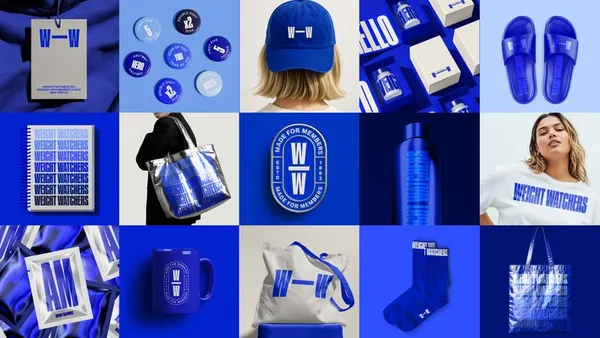Retail media is one of the key marketing channels that saw accelerated growth due to changing consumer behaviors and specific challenges related to the pandemic. Curbside pickup, home delivery and in-store fulfillment options were boosted during the period and those habits appear permanent, increasing the importance of retail media networks.
That’s especially true for CPG marketers like Georgia-Pacific, with a portfolio that includes paper product brands like Angel Soft, Quilted Northern, Sparkle and Brawny.

“I'm not sure if you heard, but there was a toilet paper shortage in 2020,” joked Paras Shah, senior director of digital media at the CPG giant, during a panel discussion at Marketing Dive and Grocery Dive’s recent co-hosted virtual event, “How to Navigate and Capitalize on Retail Media Networks.”
Shah leads programmatic media, social media, search marketing and retail media across Georgia-Pacific's brands, and since 2020, he has led the transformation of the company’s omnichannel marketing strategy, with a special focus on retail media.
The following Q&A draws from a larger conversation that occurred during a virtual event and has been edited for clarity and brevity. You can register here to watch a replay of the full event.
MARKETING DIVE: How can retail media help marketers better connect with consumers where they are?
PARAS SHAH: Marketers can target consumers based on purchase history, browsing habits and personally identified preferences, and ensure that ads are relevant and align with their current needs. That wasn't necessarily the case pre-COVID, when retail media was not as well developed. But that really accelerated how many people signed up for retail or mobile apps. It accelerated how much first-party data was available for the retail media networks to be able to turn around and use.
Ads are also now being placed more directly within the shopping experience, like with retail search ads or in-store via in-store videos and digital signage. They're all being developed to reach consumers closer to the point of purchase, but they're being done in a way that's minimally disruptive, while also increasing the likelihood of engagement.
Retail media networks are also starting to build off-site shoppable ads in digital media using programmatic offsite, YouTube Shorts, Instagram, connected TV, where marketers can connect with shoppers to complete purchases directly through the ad. That helps meet the consumer at the moment of intent, and it makes it very frictionless and improves that convenience factor.
Real-time insights into ad performance that some of these retail media networks are offering really help marketers adapt in a very agile way, based on the consumer's response to the ads. And then they use this data to then optimize their campaigns for better results.
By focusing on relevance, convenience and the ease of integration into that marketing ecosystem, retail media really allows marketers to connect with consumers at very crucial moments along the path to purchase.
How can marketers use that retail data to better target their campaigns?
Retail media uses the same channels, capabilities and platforms as your national digital media. Retail media can offer data that enables better targeting, but that's only when you really tap into and leverage the power of that better targeting.
Contextual relevance is key. We leverage curated sites and publishers, and we have them serve ads when consumers are engaging in relevant activities. We've also looked at targeting based on demographics and life stages. That's a key benefit of retail media networks: data on household size or family composition can really help marketers select specific messaging or creative.
"Data is at the heart of everything that Georgia-Pacific does."

Paras Shah
Senior Director of Digital Media, Georgia-Pacific
Data is at the heart of everything that Georgia-Pacific does. We try to make sure that we leverage data to activate against so that we can make sure that we're reaching the consumer across the different points in the purchase journey.
Where are the insights and strategies for retail media coming from agency partners or in-house?
At Georgia-Pacific — and I consider this one of our competitive advantages — we've built an entire in-house capability. Our programmatic media, search marketing and paid social are bought in-house. We’re able to leverage our in-house team of practitioners and specialists to work with our brand teams and cross-functional partners — sales, supply chain, finance — to plan what we want to accomplish and how we want to accomplish it.
They're the ones who go activate and come back and share with their counterparts, what we're learning, what insights they’re gaining from the activations, what's working, what's not working, how efficient and effective things are. Then they're making changes on the fly to optimize and make sure that we're creating more value with investments in the space.
How do you approach measurement in a retail media space that doesn't have a lot of standardization yet?
That continues to be a pain point for Georgia-Pacific. We want to invest in retail media to drive incrementality for a business, and there is no standardized way of measuring incrementality. Everything we found is kind of apples to oranges, so we use our own media mix modeling to be the determinant of how effective something is — that’s the single source of truth.
First, we try to standardize our investments across our internal measurement capabilities. We try to find a balance of efficiency and effectiveness metrics that meet both the brand and the sales teams’ priorities.
Second, we’ve created a retail media measurement framework. We look at KPIs that are more aligned to the marketing objective based on the stage of the funnel or target audience.
Third, having guidelines for in-campaign optimization and post-campaign evaluation, where capabilities exist, is also important. But that’s our tertiary priority, because that's only going to tell you so much.
"I always like to remind every retail media network, that is your full funnel, not my full funnel."

Paras Shah
Senior Director of Digital Media, Georgia-Pacific
We like to think of everything as an investment. So we want to make sure that the KPIs are set so we can drive investor confidence in our retail media spend.
Do you think retail media networks are contributing to media fragmentation?
Retail media networks are becoming their own walled gardens, but it's a bit nuanced. Much like Google, Facebook and Amazon, retail media networks have access to a significant amount of first-party data, particularly around purchase behavior, loyalty data and in-store activity. But as the retail media networks grow, they tend to limit the data sharing. They keep more valuable audience insights and performance metrics restricted to their own platforms.
The challenge for marketers lies in navigating these ecosystems in walled gardens and negotiating for visibility into the measurement and performance across the multiple retail media platforms and within the walled gardens.
Retail media networks often try to lock you into a full-funnel campaign. But I always like to remind every retail media network, that is your full funnel, not my full funnel.
What should marketers that are looking to invest in retail media for the first time be thinking about?
Marketers should make sure that their investments align with their objective. If they're just getting into retail media for the first time, make sure that whatever they're investing in is actually driving their objective. Too often I've seen where marketers are doing what retail media networks tell them to do without actually delivering on their business objectives. There is sometimes a misalignment of incentives.
Back when we started on this journey, we flipped the funnel. We started with the bottom of the funnel, and we wanted to see where we could maximize those consumers who are ready to convert. Then we worked our way down the funnel to drive more awareness and consideration, so that we can hold those consumers’ hands and hearts through the non-traditional, non-linear path to purchase all the way through conversion again.
By flipping the funnel, we were actually able to make sure that the retail media was used to drive sales and market share gains across the appropriate fulfillment options most efficiently and effectively. That's what I recommend to any marketer who's trying to invest in it for the first time.






















